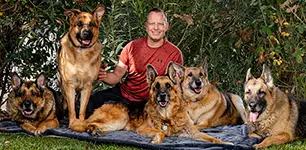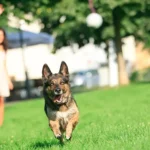
The Truth About Pit Bulls was written by internationally acknowledged dog trainer Chad Mackin and reposted with his permission. Please check out Chad’s online sources below. Consider subscribing to his podcast “Something to Bark About” and following him on Facebook. Dog owners and dog trainers equally enjoy his thoughtful insights.
This is the most thorough description of the nature of pit bulls I have read to date, and I couldn’t have said any of this better, which is why I asked Chad’s permission to publish it on my site. This post includes references to dogfighting, as this is part of the breed’s history. Still, in no way, shape or form should any part of this post be interpreted as an endorsement or apology for this horrible activity or the people who engage(d) in it.
The post also references the book Dogs of Velvet and Steel by Bob Stevens. This book was not written by a stellar human being, as he did engage in dogfighting himself, as I understand. However, this book is considered the best resource for understanding pit bulls written to date. It shouldn’t be necessary to clarify these things up front, but this is the Internet, and I know it needs to be spelled out for some.
The Truth About Pit Bulls by Chad Mackin
I’ve seen a lot of posts about pit bulls lately. Some are written to defend them, others on why their history makes them more dangerous than other dogs. Almost everything I’ve read misses the point in big ways. So, let’s get our hands dirty and get into some controversy, shall we?
If you take to either of the following lines about pit bulls, you are probably not going to like what I will say.
Contrary to what many believe, it isn’t all about how you raise them. The fact that pit bulls were originally bred for fighting doesn’t automatically make them aggressive. And no, they were never (as far as I can tell) called “Nanny Dogs,” but I can think of no dog with better skills to be trusted around children than an old-school fighting pit dog.
This is a simple fact that should be obvious to everyone who knows anything about dogs and dog breeding. Anytime we make a blanket statement about a breed’s temperament, we will be wrong about a large portion of individuals. The further we move away from purpose breeding, the less we can count on temperament.
Breed Purpose
Yet, pit bull apologists, advocates, and detractors equally pretend this isn’t true. They don’t seem to understand that generations of random breeding led to wildly varying temperaments. Obviously, there is a difference between the results of purpose breeding and random breeding. How could it be otherwise?
Few pit bulls are purpose-bred these days, and even fewer are bred for fighting—thankfully. This means there no longer is a consistent temperament in the breed.
The modern pit bull is as likely to be a couch potato as he is to be dangerously aggressive.
Dog Fighting
We must first understand what they were bred to do to understand this. It’s not as easy as saying, “They were bred to fight,” unless we understand what dog fighting was actually about. When we hear of dog fighting, most of us think of what Michael Vick was convicted of doing. That is dog fighting, but it bears almost no relation to the type of dog fighting pit bulls were bred for. Let me stress before I go further; there is no “good” way to fight dogs. It’s always wrong, and it always has been wrong. Nothing I say in the following should be interpreted as a defense of dog fighting. However, we cannot understand what makes pit bulls without understanding the task they were bred to perform.
Gameness
Traditionally, dogfighting wasn’t a test of the dog’s fighting ability. The old pit men fought their dogs to test for a trait called “gameness.” Gameness is a particular type of tenacity in the face of adversity. The idea of the game dog is a dog who, once dedicated to a task, will never stop trying, no matter how hard it gets. As one dogfighter put it,
Gameness is not the willingness to fight. It’s not the courage to be killed by a better opponent. It’s the will to win.
According to the old pit bull books, this will to win, this gameness, should be stronger than the dog’s will to survive. And this trait was what the pit bull was bred for, above all else. It was this trait that dogfighting was supposed to test. The rules of the old dog fights reflect this. If a dog’s owner stopped a battle because his dog was losing and refused to quit, his reputation as a dog man wasn’t tainted by that. His dog wasn’t the best fighter, but he never stopped trying to win, and that was the exact trait they were looking for.
This, above all else, is what makes a good pit bull. That single-mindedness of purpose when the chips are down should be the breed’s hallmark.
Gameness vs. Aggression
Unfortunately, many confuse gameness with aggression, which is not a new problem. Reading old pit bull books or magazine articles, the authors have to remind the reader a few times that aggression and gameness aren’t necessarily related. Consider this passage from the book “Dogs of Velvet and Steel”:
Folks who don’t know much about pit bulls, are inclined to consider aggressiveness to be gameness. As I mentioned earlier, there is no correlation between the two. Many dogs of other breeds will aggressively snarl, attack, and bite. The game dog will stay and fight no matter how hard he is bitten or tossed around. The dog that is not game will give up when bitten hard enough or after fighting a relatively short time without winning. The point is this – the dog who is aggressive is not necessarily game – and the dog who is passive may be the gamest one in ten counties.
Aggression wasn’t selected against, but according to all the sources I can find, it wasn’t particularly sought after either, at least not by the most knowledgeable minds.
However, there are many traits a dog could be bred for that would help him in a fight, and there’s no way they wouldn’t have been selected for, along with that cardinal trait of gameness.
Other Pit Bull Traits
For a pit bull to be successful, he had to enjoy conflict. It doesn’t matter how game he is if he doesn’t set his mind to winning the fight. So a desire to engage in conflict was essential. But that doesn’t necessarily mean a fight. It merely means overcoming resistance. A game dog might grab hold of a tree root and spend hours trying to pull it from the ground. This is one of the reasons weight pull remains a favorite sport for pit bulls.
A successful pit dog would also have to have a high pain tolerance. It’s all well and good that the dog won’t quit no matter how tough the going gets, but the less pain bothers him, the longer he can go before not stopping requires gameness. So dogs who were mostly immune to pain had a distinct advantage.
A fighting dog would also benefit from being physically powerful.
Social Attachment
The above traits were beneficial but, strictly speaking, not necessary. Finally, there was one non-negotiable quality. A fighting dog had to have an incredible social attachment to humans. The attachment had to be strong enough to create an extreme aversion to biting humans. Not just humans he knows, but any humans. There were always three people in the pit during a dog fight, two of them often entirely unknown to the dog.
These people would have to handle the dog while he’s in full drive and possibly when he’s injured. If the dog posed any threat, he would not be permitted into the pit. In fact, he would not be allowed to live. The old pitmen had no tolerance for human aggression. Dogs who showed the slightest hint of it were culled without hesitation. They were playing a dangerous game and understood the consequences of having a dog with the abilities of a fighting dog, who decided to turn those traits towards human prey.
The Modern-Day Pit Bull
And that brings us to the modern world of pit bulls.
The absence of purpose breeding means most pit bulls are a grab bag of traits. Most of the ones I have met in my career would be better described as pet bulls. The most conflict they want is a little bit of tug or chasing a treat. They are generally happy being couch potatoes. They have strong social attachments, which is why pit bull advocates and apologists are so vigorous in their defense of the breed. Few dogs will love you as much as a good pit bull because few have been selected for that trait as much as they were.
If you have a pit bull who is physically tough, has a strong social attachment to humans, and is game about that attachment, you may have the ideal dog for children to interact with. They are going to be more tolerant of the clumsiness of the child. If the child pulls an ear or pokes an eye, that dog is far less likely to bite the kid than a less game, socially attached, and physically tough dog. Of course, you should NEVER rely on the dog to make good judgments around kids. I’m not suggesting anything otherwise. But I do think this is where the Nanny Dog idea comes from. The margin for error in allowing interactions between dog and child is more substantial with the dog I’ve described above than with a dog without those traits.
If, on the other hand, you get a dog who loves conflict, is physically strong and game, but lacks that sort of social attachment to humans, you legitimately have a potential nightmare on your hands. It really can go either way.
The Lack of Purpose Breeding
However, I find that if the dogs aren’t bred for a purpose, most end up in the pet bull category. This makes sense because gameness isn’t a great survival strategy, especially at the level the old dogs were bred to. The dogs who make it to reproductive age are more likely than not to be the ones who are easiest to live with. That’s human behavior.
At this point in history, however, there is no standard pit bull temperament, at least not one you can count on. I believe there are so many conflicting reports about pit bulls due to the lack of purpose breeding. The dogs are changing, and not necessarily in good ways.
A Sport for Pit Bulls
Thankfully, there is hope for the pit bull. There is a new sport designed to encourage owners to develop and celebrate the traits that made pit bulls such great dogs years ago—without the bloodshed. It’s called GRC, which stands for Gameness, Relationship, and Control. The sport stresses social responsibility (relationship and control) along with gameness. I believe this sport is the best thing to happen to the breed since fighting them was outlawed. While it was designed with pit bulls in mind, it’s open to all breeds. If you want more information about it, you can go to GRC Dog Sports.

Chad’s Website: PackToBasics.net
Chad’s Podcast: Something to Bark About
Chad on Facebook: Chad’s Profile
Chad Mackin is an internationally acknowledged dog trainer of 27 years, founder and owner of the dog training company Pack To Basics, former president of the International Association of Canine Professionals and head trainer of 4 Paws Activity Center.




